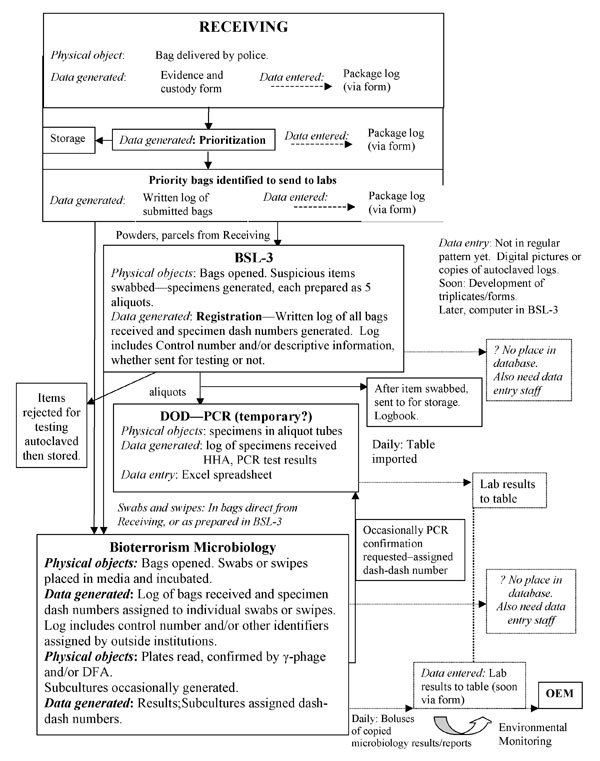Volume 8, Number 10—October 2002
THEME ISSUE
Bioterrorism-related Anthrax
Bioterrorism-related Anthrax
Laboratory Response to Anthrax Bioterrorism, New York City, 2001
Figure 3

Figure 3. Depiction of the data flow at the New York City Bioterrorism Response Laboratory adopted soon after the surge of isolates after the bioterrorism attack. An access database was developed, and a number of demographic fields and test results were identified and entered. Data retrieved from the Biosafety Level 3 (BSL-3) laboratory after suspicious packages were opened had to be input into the database; the original documentation was modified if any additional information was identified. An attempt was made to monitor all transactions occurring to the sample, which began to make the system unwieldy. The database was modified numerous times and recently was entirely replaced. Most of the comments, such as “no place in database” have been corrected. PCR, polymerase chain reaction; DOD, Department of Defense; HHA, hand-held analysis; DFA, direct fluorescent-antibody assay; OEM, Office of Emergency Management.
1 The Joint Microbiological Rapid Response Team consisted of the Biological Defense Research Directorate, Naval Medical Research Center, Bethesda, Maryland: F. Baluyot, M. Boyd, and T. Hudson; 4th Medical Support Squadron, Seymour Johnson Air Force Base, North Carolina, USA: L. M. Bayquen and L. Galloway; and 7th Medical Support Squadron, Dyess Air Force Base, Texas: L. De Los Santos and C. Sekula.
2 The New York City Anthrax Investigation Working Group consisted of Division of Vector-Borne Infectious Diseases, Centers for Disease Control and Prevention (CDC), Fort Collins: May Chu, David Dennis, Kathleen Julian, Anthony A. Marfin, and Lyle Petersen; CDC, Atlanta: Mary Brandt, Richard Kanwal, Kristy Kubota, Els Mathieu, Steve Ostroff, John Painter, Dejana Selenic, Allison Stock, Linda Weigel, and William Wong; New York City Department of Health: Neal Cohen, Laura Mascuch, Denis Nash, Sarah Perl, and Don Weiss; New York City Public Health Laboratories: Alice Agasan, Jay Amurao, Josephine Atamian, Debra Cook, Erica DeBernardo, Adeleh Ebrahimzadeh, Philomena Fleckenstein, Anne Marie Incalicchio, John Kornblum, Ed Lee, William Oleszko, Lynn Paynter, Alexander Ramon, Chiminyan Sathyakumar, Harold Smalls, George Williams, Marie T. Wong, and Ben Y. Zhao.